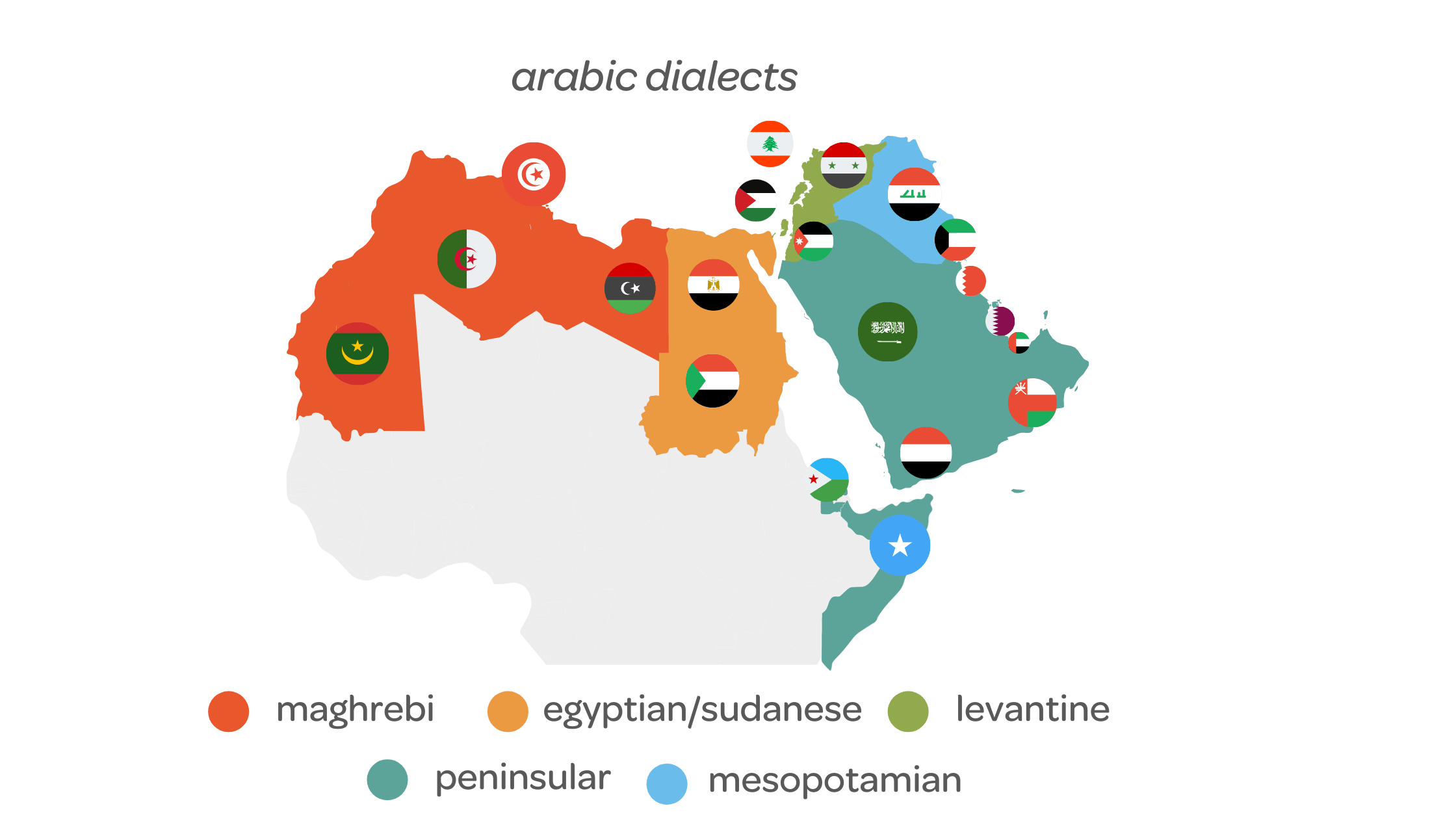In the Arab region, there are dozens of spoken dialects, hundreds of colloquial variants but one single and universal written form of modern Arabic, known as Modern Standard Arabic (MSA), used in everyday written communication.
written forms of Arabic
there are three key written forms of Arabic that linguists need to be aware of.
the highest refined form
Qaran and religious writings
the higher refined form
the literary form that includes Biblical translations into Arabic, older Arabic literature and poetry, prose with linguistic artistic expressions
the high standard form
known as Modern Standard Arabic (MSA) used in official documentation, formal correspondence media, contemporary literature, business, academia and other communication material
The spoken form, on the other hand, is very diverse and includes a wide variety from one Arabic-speaking country to another. Additionally, there are local in-country variations of vernacular dialects and a plethora of accents. These are geographically based and are influenced by a number of factors, such as historical origin of people, migration, integration, colonization, globalization, trade and occupation, etc. These are known in Arabic as ‘Ammiyyah (Colloquial) and/or Darijah (Common). The colloquial is more area-specific; the common is more country-specific.
When it comes to translating written texts, we need to focus entirely on MSA. Again, this is the unified and universal form practiced in Arabic speaking countries and serves its purpose equally, East to West. The MSA is also used and understood in all other countries where Arabic is a second or a third language. Do not be distracted or discouraged by the many Arabic variants as these mostly have to do with the spoken form, not the written form.
When it comes to localization, MSA is the only written form used. However, there are certain differences that have to deal with the choice of vocabulary, names of entities or local terminology. This is where we would need a translator from a certain country to apply any certain changes required, and edit and adapt your text for localized use in Arabic.

Highly technical terminology in political, medical, military and industrial fields are maintained by a number of entities and services, such as the UN term portal, the WHO EMRO-UMD, Microsoft Language Portal, the International Telecommunication Union Term Portal, and others. Professional translators are well experienced in the use and application of such databases and term portals and have hands-on experience in handling acronyms, abbreviations and initialisms.
Cultural aspects and differences should also be observed when translating into Arabic for a target audience living in the source language countries. For example, translating US or UK material into Arabic for the Arabic-speaking communities residing within the USA or the UK might require certain linguistic and sociocultural elements that differ when the target audience is the Arabic-speaking communities living within Arabic speaking countries.
did you know?
considerations in translation
Arabic, being a Semitic language, is written right to left. Therefore, when translating tables or illustrations, alignment must be observed. However, maps, X/Y graphs/charts, numbers such as postal codes and phone numbers should maintain their position without change.
Skopos is important when translating into Arabic. This summarizes the purpose of the source text and the target text, the target audience, the language style and level, the focus of the text whether it is a product a process or a function.
The consonant letter ع is not present in any other language but Arabic. Therefore, names starting with this letter, for example, were conveyed using the vowel that comes right after it (a diacritic mark in Arabic). This resulted in different Alphabetic order of such names in other languages. Country names such as Iraq, Oman and proper names such as Ali, Omar, start in English with the diacritic mark or vowel that comes after their actual first letter, which is ع. The sound of ع is not present in other languages -which is why it is omitted in English. You might be surprised to learn that the words Arabic and Arab also do not start with the letter A, but with the letter ع and its unique phonetic sound. (Note the first letter to the right: Iraq عِراق – Oman عُمان – Ali علي – Omarعُمر – Arabic عَربية – Arab عَرب.)
Specialization is important and is a great asset. For example, Translating taxonomy for the fauna and flora requires appropriate knowledge in biology and nomenclature (Greek, Latin, English and Arabic).
There are no acronyms or abbreviations in Arabic except within a limited scope. For example, the USA, the UK, the MENA, the GCC, the UNDP, the UNFPA, the UNW, HIV, etc. are put in their full Arabic form. However, acronyms such as the UNICEF, the UNESCO, the NATO, the BBC, AIDS and others are transliterated phonetically, written in words as pronounced. Abbreviations that are in use include company formations such as LLC ذ.م.م , SA ش.م; NASA and DNA are written with letters conjoined, ناسا، دنا, respectively; MR and MRS are written in full form السيد/السيدة.
Numerals in Arabic keep their western form if alphanumeric, such as AC35B6; but are put in Eastern Arabic (aka Hindi) when used as numbers or digits: 0 1 2 3 4 5 6 7 8 9 10
considerations in localization
Localization in Arabic mainly has to do with the choice of vocabulary and names of entities, but the language remains the same, MSA.
A translated written text in MSA serves its purpose throughout Arabic speaking countries. Whereas a spoken dialogue in Moroccan Arabic may not be easily understood in Iraq, for example.
The spoken-form Arabic is never used in written texts, unless precisely requested for certain material, such as TV commercials or animated advertisements.
The main subcategories of the written form are thematic and temporal: Quranic, Literary and Modern Standard.
The main subcategories of the spoken form are geographical and vocational: Peninsular, Mesopotamian, Levantine, Egyptian/Sudanese, Western/Maghrebi (North African & Moroccan).
A translated written text in MSA serves its purpose throughout Arabic speaking countries. Whereas a spoken dialogue in Moroccan Arabic may not be easily understood in Iraq, for example.
In the filming industry, successful subtitled productions are those translated into MSA, as these can be easily understood by ALL people who speak Arabic. Dubbed productions are also made in a spoken MSA, except where a local dialect is specifically requested for local use. Cartoons are also subtitled and/or dubbed in MSA as a standard practice. Those done in a single spoken dialect (e.g. Egyptian, Syrian or Khaleeji) are more likely to lose the wider region popularity and audience.
Arabic songs are in the spoken form using dialects. However, there are songs written and sung in MSA and achieve greater popularity. National Anthem lyrics are also written and sung in MSA.
Unlike English, some of the oldest forms of Arabic, aka pre-Islamic Arabic, are still understood by today’s Arabic speakers, with the help of annotated vocabulary. The Seven Odes, for example, date back to the sixth century CE and were also successfully translated into English by A. J. Arberry. This written form comes under the second higher refined form of written Arabic.

importance of cultural translations
We are experts in both language and culture, ensuring an accurate Arabic translation every time. This means more effective communication, resulting in improved healthcare and ultimately savings for the providers with greater consumer compliance to policy and/or guidelines.
we can help you with Arabic translations
find out more information on CQ fluency’s unique approach to Arabic Language translations

